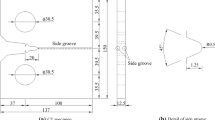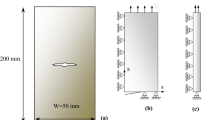Abstract
Low-cycle fatigue is one of the failure modes in steel structures during earthquakes. With a focus on crack growth in the low-cycle fatigue region, this study developed a fatigue crack growth curve and verified its applicability to crack growth prediction in welded joints. Fatigue crack growth tests under highly plastic conditions were performed using compact tension specimens with side grooves. The results indicate that the crack growth rate in the low-cycle fatigue region correlates with the cyclic J-integral range, which can be calculated using finite element analysis. Additionally, the results for both plain steel and weld metal were distributed in the same region within a narrow band. Based on the results, a formula for the fatigue crack growth rate under large cyclic strains was proposed. Low-cycle fatigue tests were then performed on welded joints to clarify their crack growth behavior, and the crack growth observed in these tests was compared with the crack growth calculated using the proposed formula. The calculation results were found to be in relatively good agreement with the experimental results, verifying the applicability of the formula.




















Similar content being viewed by others
References
Okashita K, Ohminami R, Michiba K, Yamamoto A, Tomimatsu M, Tanji Y, Miki C (1997) Investigation of the brittle fracture at the corner of P75 rigid-frame pier in Kobe Harbor Highway during the Hyogoken-nanbu Earthquake. J JSCE 591/I-43:243–261 (in Japanese)
Manson SS (1953) Behavior of materials under conditions of thermal stress, NACA technical note, 2933
Coffin LF Jr (1954) A study of the effects of cyclic thermal stresses on a ductile metal. Trans ASME 76:931–950
Tateishi K, Hanji T, Minami K (2006) A prediction model for extremely low cycle fatigue strength of structural steel. Int J Fatigue 29(5):887–896
Paris P, Erdogan F (1963) A critical analysis of crack propagation laws. Trans ASME J Basic Eng 85(4):528–533
Dowling NE, Begley JA (1976) Fatigue crack growth during gross plasticity and the J-integral. ASTM STP 590:82–103
Dowling NE (1976) Geometry effects and the J-integral approach to elastic-plastic fatigue crack growth. ASTM STP 601:19–32
Tanuma Y, Kobayashi H (2002) Study on ultra-low-cycle-fatigue crack growth characteristics of high strength steel. J Struct Constr Eng 553:105–112 (in Japanese)
Shih CF (1981) Relationships between the J-integral and the crack opening displacement for stationary and extending cracks. J Mech Phys Solids 29(4):305–326
Schweizer C, Seifert T, Nieweg B, Hartrott P, Riedel H (2011) Mechanisms and modelling of fatigue crack growth under combined low and high cycle fatigue loading. Int J Fatigue 33(2):194–202
Haigh JR, Skelton RP (1978) A strain intensity approach to high temperature fatigue crack growth and failure. Mater Sci Eng 36(1):133–137
Kamaya M, Kawakubo M (2012) Strain-based modeling of fatigue crack growth—an experimental approach for stainless steel. Int J Fatigue 44:131–140
Kamaya M (2015) Low-cycle fatigue crack growth prediction by strain intensity factor. Int J Fatigue 72:80–89
Bui-Quoc T, Biron A (1978) Comparison of low-cycle fatigue results with axial and diametral extensometers. Exp Mech:127–133
Rice JR (1968) A path independent integral and the approximate analysis of strain concentration by notches and cracks. J Appl Mech 35:379–386
Hanji T, Park JE, Tateishi K (2014) Low cycle fatigue assessments of corner welded joints based on local strain approach. Int J Steel Struct 14(3):579–587
Acknowledgements
The authors acknowledge the support of Chubu Electric Power Co., Inc. in Japan and express our sincere gratitude to Dr. Matsumura at The Takigami Steel Construction Co., Ltd. in Japan for specimen fabrications.
Author information
Authors and Affiliations
Corresponding author
Additional information
Recommended for publication by Commission XIII - Fatigue of Welded Components and Structures
Rights and permissions
About this article
Cite this article
Hanji, T., Tateishi, K., Terao, N. et al. Fatigue crack growth prediction of welded joints in low-cycle fatigue region. Weld World 61, 1189–1197 (2017). https://doi.org/10.1007/s40194-017-0504-3
Received:
Accepted:
Published:
Issue Date:
DOI: https://doi.org/10.1007/s40194-017-0504-3




